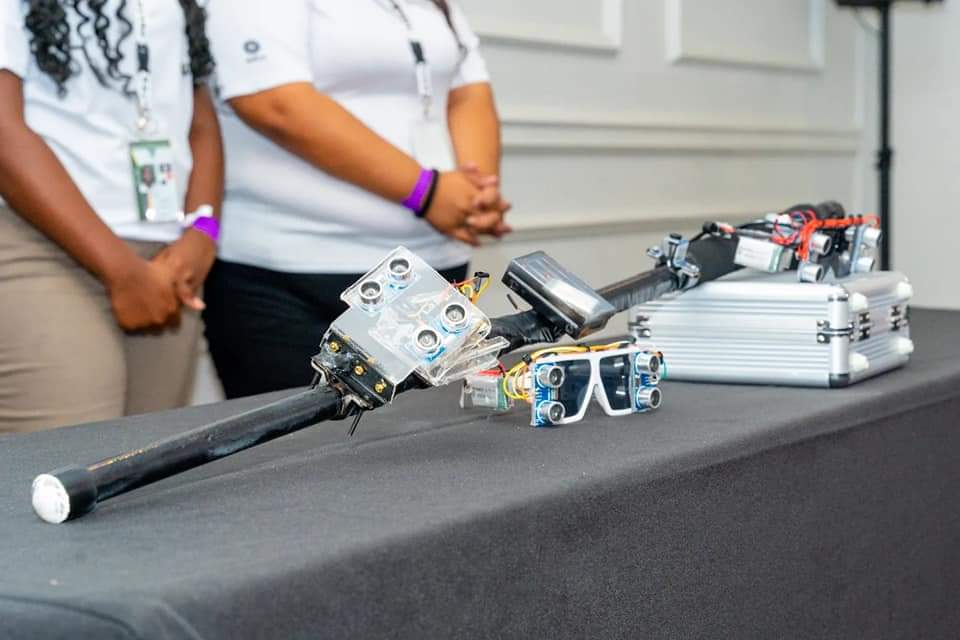A two-piece set device detects obstacles and prevents injuries for non-sighted or with impaired vision people. That was the main idea that made SMARTZ the winner of the 10th edition of Solve for Tomorrow – Central America and Caribbean region, which gathers together 11 countries: Barbados, Belize, Costa Rica, Dominican Republic, Ecuador, El Salvador, Guatemala, Honduras, Nicaragua, Panama and Venezuela. The project was created by four teenage girls and a mediator teacher from Belize, a small country in Central America with a population of about 400 thousand people.
The device uses robotics intelligence to detects obstacles at a distance of three to five feet (or 0,9 to 1,5 meters) away and send it via vibrational stimulation to alert of danger ahead: the Smart Stick, focused on obstacles at the level of the waist, and the Smart Glass, in the level of the head or face.
It all started with an exercise of empathy that actually took place naturally. The group noticed that a blind student at school had to face different challenges around mobility. “We decided to brainstorm to think about something that we could create to actually assist that student. That was when we came up first with the Smart Stick”, says Abraham Flowers, the teacher responsible for the project.

After researching, the team discovered that there were two fundamental traumas that usually occur within a blind person: trauma and fall. “So then we decided to do the Smart glasses as well, to protect the head and the face”, remembers him.
The participants are four girls from secondary school, from the ages of 14 to 16, from Pallotti High School (PHS), a Catholic high school that offers its students a wide range of learning opportunities in academics, athletics, performing arts, and extracurricular activities. It is an only-girls public-private school.
They were selected by Flowers, based on their dedication and participation in the class. Since Belize’s school year begins in August, the students began the project still in one grade, but then ended up at the Solve for Tomorrow Ceremony already the grade ahead.
Combining health and technology, SMARTZ is an example of the work Flowers is doing at Pallotti High School. He is a medical doctor and an educator, but has also acted in other areas, such as robotics. He founded the PHS Robotics Club (Rotec) back in 2022, where students can participate in projects that combine STEM (Science, Technology, Engineering and Math) and health.
That unexpected reaction made them wonder what was wrong, so they reassembled the robot, but it didn’t fix the problem and they put it aside. Just when one incident happened with the same type of wire, they realized that they were using corroded wire in all devices. “The issue was due to a poor quality of the wires. We had to change all of the wires and then when we turned it on, Tim finally worked. It was eureka! We finally figured it out and discovered that the simplest item in robotics can be essential”, concludes the teacher.
Getting the list of items done
At first, the team didn’t have most of the materials available at school; from the adapter wires to the ultrasonic sensor that were used to detect the obstacles. “At one point we had to use what was around us”, emphasises him. For instance, at first the idea was to work with an aluminium stick, but they replaced it with PVC pipe painted in black, which is used in water systems at homes.
The pieces that needed to be purchased were bought with parental donation and personnel contribution and some of them needed to be ordered online and it took a lot of time to arrive. “Meanwhile, we were working on coding. When all the materials needed arrived we basically assembled it all together”, tells Flowers. He says being part of Solve for Tomorrow was important at this point: “It was like a trampoline for us to jump higher and to reach further. We got more publicity which allowed us to get financed”.
When the first version of SMARTZ was ready, they tested it with the blind student from school. “For our amusement, it worked; it had at least 80% of efficiency. We gathered all the feedback and results and we were happy to see it wasn’t heavy, it didn’t provoke electroshocks and it wasn’t harmful”, informs the teacher.

Device can be produced in a larger scale
Another SMARTZ sample can be made within hours, if all the materials are available. Thus, it can easily gain scale and be replicated in other schools or other places around the world. “We expect to start to do a mass replication of these devices in the future. The prototypes that we presented were just for teenagers, but it can be adjusted to all ages, from babies until the elderly”, says Flowers.
They are already thinking about the following steps, searching for more financial support to produce five to ten replicas to put on a broader trial, to have accumulative feedback from more people, from different backgrounds.
He also evaluates that the Solve for Tomorrow experience contributed a lot to their leadership spirit and responsibility development, because of the visibility they had presenting the project to a jury and winning a competition in a multi-country range. “When we were in Panama receiving the prize, the students still could not believe they were living the dream. And I said to them that this is what happens when you are dedicated to actually making a change”, says.
This experience showed them that technology has a wide era of development and they could be part of it. That is very important for students at that age to actually think they’re able to conquer stars, believes Flower.




